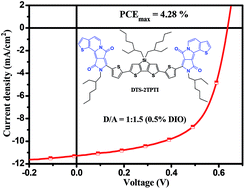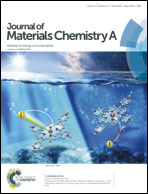Designing a thiophene-fused DPP unit to build an A–D–A molecule for solution-processed solar cells
Abstract
A novel thiophene-fused diketopyrrolopyrrole unit (7H-pyrrolo[3,4-a]thieno[3,2-g]indolizine-7,10(9H)-dione, PTI) has been designed as an electron acceptor with the 4,4′-bis-(2-ethylhexyl)-dithieno[3,2-b:2′,3′-d]silole (DTS) unit as a donor to construct a new kind of A–D–A molecule (DTS–2TPTI) for solution-processed solar cells. DTS–2TPTI exhibits excellent thermal stability with the decomposition temperature over 400 °C and shows strong absorption from 550 to 750 nm with a high molar extinction coefficient. The optical band gap (Eg) estimated from the absorption edge of the thin film is about 1.44 eV. The highest occupied molecular orbital energy level of DTS–2TPTI determined from CV is about −4.99 eV. Through optimizing the photovoltaic performances of devices, the DTS–2TPTI/PC71BM-based solution processed bulk-heterojunction solar cell with 0.5% DIO as a solvent additive exhibits the best photovoltaic performance with a JSC of 11.28 mA cm−2, VOC of 0.64 V, FF of 59.5% and power conversion efficiency (PCE) of 4.28%, indicating that the PTI unit can act as an efficient acceptor moiety to construct D–A small molecules for OPVs.


 Please wait while we load your content...
Please wait while we load your content...